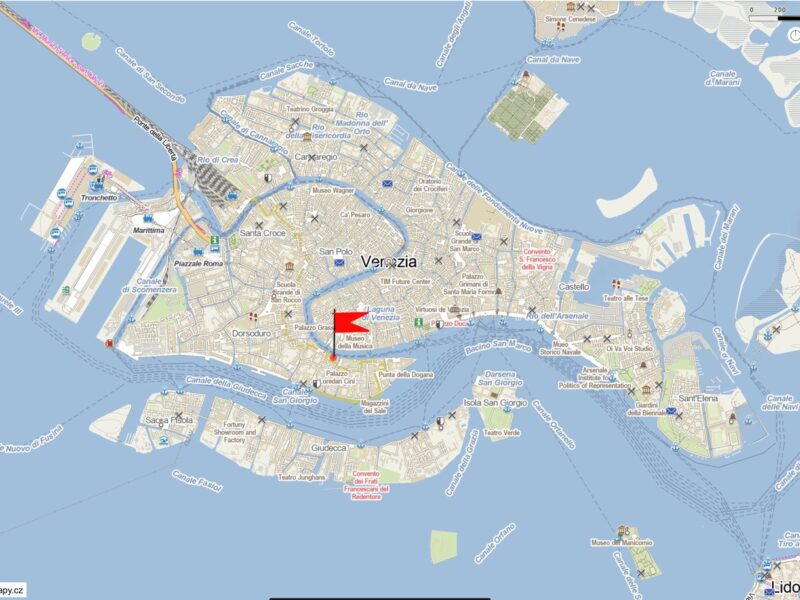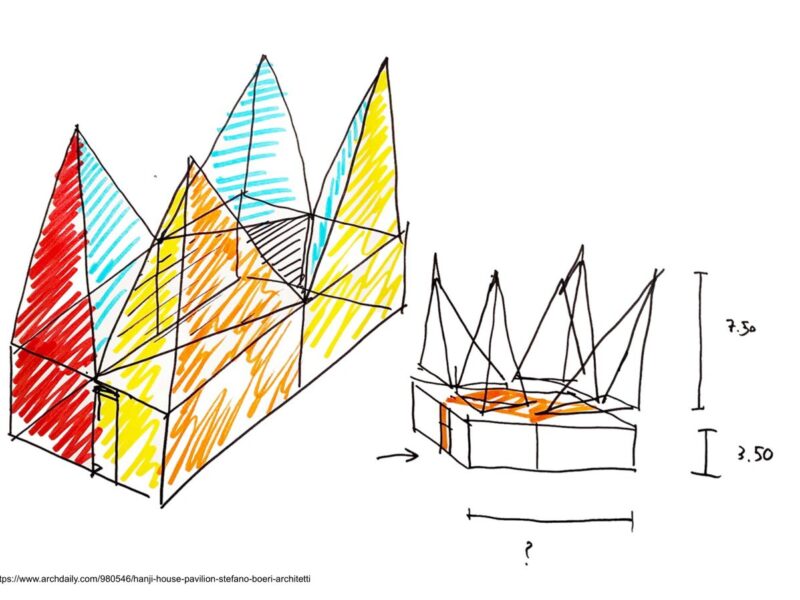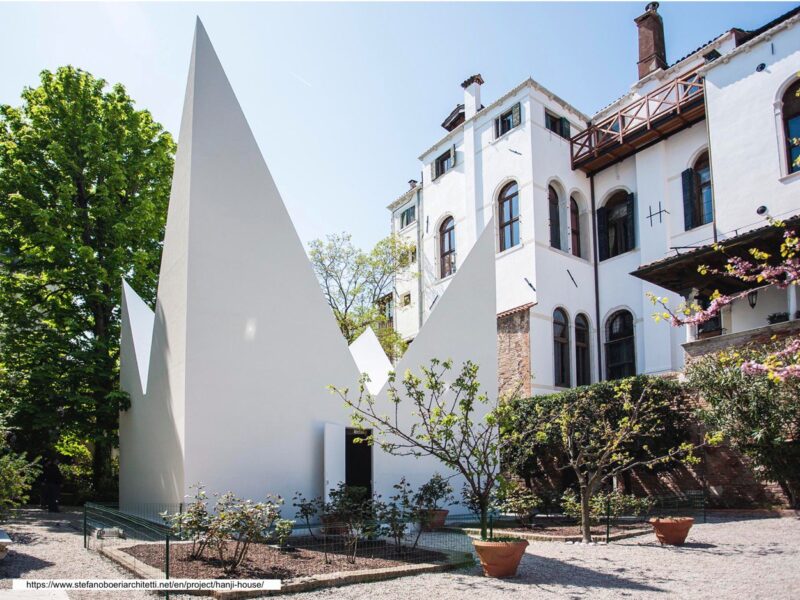Hanji House






autorský popis projektu
zdroj: https://www.stefanoboeriarchitetti.net/project/hanji-house/
Hanji House is the introductory pavilion to the exhibition Times Reimagined, dedicated to Korean artist Kwang Young Chun’s works as a collateral event for the 59th Venice Biennale. Located in the garden of Palazzo Balbi Valier, with access from Palazzo Contarini Polignac (Dorsoduro 874), Hanji House becomes a new temporary landmark for Venice, visible from the Grand Canal.
Its shape and identity derive from the ancient, playful yet meditative oriental practice of folding paper in an infinite number of ways. The basic principle of the game is to transform a flat sheet of paper into a complex three-dimensional shape, constantly challenging the stability of the structure through a series of metamorphoses. Hanji House is based on the unpredictability of creativity, but guided by mathematical precision: the pavilion is a mutating object that undergoes continuous transformations within itself through the play of light and shadow.
The shape is reminiscent of the ancient oriental practices of origami and tangram, as well as traditional Japanese and Korean houses based on a simple geometric modularity. In this case, the combination of volumes is articulated starting with four pyramids surmounting a parallelepiped, leaving a flat rhomboidal surface in the centre. Although perfectly symmetrical, Hanji House has a deliberate irregularity: one of the pyramids stands out, two metres higher than the others, breaking the balance of the forms. This “tower” recalls the idea of a lighthouse and at the same time echoes Venetian architecture: the entire pavilion evokes local forms, from the Gothic cathedral to the peculiar Renaissance style of the palaces, which wind their way from the Grand Canal to the inner part of the island. The image of the lighthouse, combined with that of the paper, also underlines both the object’s origin as a symbolic point of reference and its mutable, mobile aspect.
Light, the protagonist of the space, creates constantly changing effects: from the most natural daylight, which rotates around the pavilion, to the illuminations and projections at night, which question the very form of the structure from the inside, making it appear distorted and even making it stand out completely from the perspective of the Grand Canal.
Another inspiration for this object in the waters of Venice is one of the most memorable installations in the history of the Biennale: the Teatro del Mondo, designed by Aldo Rossi in 1980. But the place where it is located, more than a destination, is to be considered a starting point for a future journey: Hanji House could be disassembled and reassembled, wherever its light might serve to attract and guide the gaze of visitors.
studentská recenze projektu
Viktoriia Iakushina, 01/2023 U6 2022 – Budoucnosti: Čas na změnu
Pavilon – origami od Stefano Boeri
Italské studio Stefano Boeri Architetti vytvořilo pro Benátské umělecké bienále 2022 pavilon s názvem Hanji House. Pavilon byl otevřen pro veřejnost v období od dubna do listopadu, a byl umístěn v zahradě Palazzo Contarini Polignac, paláce s výhledem na benátský Canal Grande. Je koncipován jako zvětšená verze soch korejského umělce Chun Kwang Younga, které byly vystaveny v paláci. Sochy Younga jsou tvořeny z tisíců trojúhelníkových skládaných korejských papírů vyrobených z moruše. Objekt byl pojmenován podle názvu tohoto korejského papíru – Hanji.
Hanji House je založen na jednoduché geometrické modularitě. Pavilon postavený z lepeného vrstveného dřeva. Je definován čtyřmi vysokými tenkými pyramidami v každém rohu. Podle ideje autora je jedna pyramida jen o dva metry vyšší než ostatní, aby narušila symetrii tvaru a vytvořila „maják“ ukazující cestu návštěvníkům. Uvnitř pavilonu je dřevěná lavička, kde mohou návštěvníci sedět a sledovat interaktivní videoinstalaci Calvina J. Lee, jenž promítá virtuální obrazy soch Younga.
Boeri je známý tím, že posouvá hranice, pokud jde o architekturu. Nejvíce je známý tím, že vytvořil termín „vertikální les“, který používá k tvorbě budov, které jsou pokryty vegetací. Proto při porovnání Hanji House s jinými projekty můžeme vidět jasný rozdíl. Na první pohled není vidět Boeriho charakterní princip práce, což ukazuje na jeho všestrannost. Jde cítit, že architekt projektoval pavilon v dialogu s výstavou umělce Younga. Hanji House již z dálky připomíná list papíru poskládaný do tradiční asijské origami, čímž naznačuje hlavní princip práce Younga. Díky volbě materiálu lze pavilon přesunout, a přizpůsobit různým kontextům s nesčetnými možnostmi transformace objektu, což je pozitivní řešení z ekologického hlediska.
Po seznámení s Hanji House vzniká pocit lítosti, že se jednalo pouze o dočasný pavilon, který většina zájemců nespatří na vlastní oči. Zároveň však vyvolává naději, že v dohledné budoucnosti vzniknou podobné zájmové objekty, které budou stejně citlivě navazovat na koncept probíhající akce.
odkazy a zdroje
zdroj informací:
https://www.dezeen.com/2022/07/02/stefano-boeri-architetti-hanji-house-pavilion-venice/
zdroj informací:
https://www.archdaily.com/980546/hanji-house-pavilion-stefano-boeri-architetti/
zdroj informací:
zdroj obrazové přílohy 1:
Mapy.cz
zdroj obrazové přílohy 2:
zdroj obrazové přílohy 3:
zdroj obrazové přílohy 4:
zdroj obrazové přílohy 5:
https://www.archdaily.com/980546/hanji-house-pavilion-stefano-boeri-architetti
zdroj obrazové přílohy 6:
